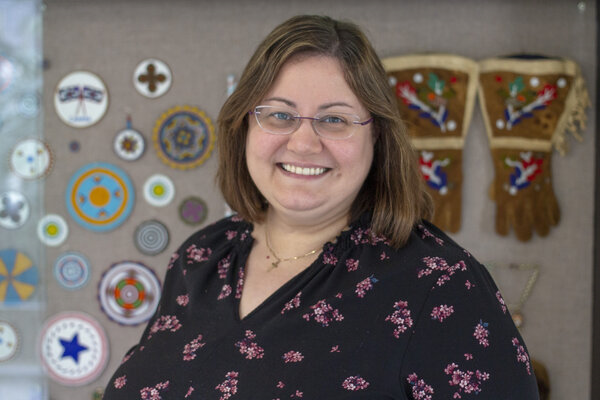
Alumni showcase decades-old beadwork through new college display
When University of Saskatchewan (USask) alumna Andrea Wasylow (BA’96) and her family found beadwork among her late grandfather’s belongings, she wanted to bring the decades-old items to the College of Arts and Science.
By Shannon BoklaschukWasylow’s grandfather, USask alumnus Walter Julian Wasylow (BEd’65, BA’68, MEd’72), passed away in 2011 following a career in education that saw him serve as a teacher, principal, guidance counsellor and district superintendent of the Battleford and Meadow Lake regions.
In the 1950s, Walter Wasylow taught at the Fort Qu’Appelle Indian Hospital and tuberculosis treatment facility—known as “Fort San”—on Treaty 4 Territory. During that time, beaded pieces were created by children, their family members and patients to sell in gift shops, and some of the intricate items ended up among his things.
Earlier this year, Andrea Wasylow’s mother, Angela Wasylow (BEd’88, BA’99), gave her the box of beadwork, which included belts, moccasins, jewelry and other pieces. Andrea Wasylow soon brought it to the College of Arts and Science to seek information and advice about the items, such as the meaning behind them and what should be done with them.
“Our college values beadwork and our college does beadwork,” she said. “It looked like a collection to me and I didn’t know what it was, but I didn’t feel like it was our family’s.”
Wasylow, who is employed as the director of planning and communications in the College of Arts and Science, consulted with Woodlands Cree artist and fellow USask alumna Vanessa Hyggen (BA’17), who serves as executive assistant to the vice-dean Indigenous in the college. Hyggen, who works with beads as part of her artistic practice, was excited about the items—particularly the circular mandalas—and set up a display on the second floor of the Arts Building to showcase the pieces as a result.
“Vanessa really took the lead and said, ‘Let’s honour this work. Let’s put it up,’ ” said Wasylow.
Hyggen said the beadwork reminds her of her kohkom (kohkom is the Cree word for grandmother). She appreciates the beauty and the history of the pieces.
“You can see everyone’s hand and love in it,” she said.
Wasylow captured on paper her reflections as a granddaughter and her memories of her dido (dido is the Ukrainian word for grandfather). Wasylow’s write-up and a photo of her dido accompany the new display.
Wasylow knew Hyggen was the right person to help honour the beadwork because of Hyggen’s previous involvement with beading in the College of Arts and Science. In February, during Indigenous Achievement Week at USask, Hyggen and renowned Plains Cree artist Ruth Cuthand (BFA’83, MFA’92) collaborated in the live creation of an art piece that blended materials and traditions to map emergent processes of Indigenization in beadwork and architectural stone.
The creation of the piece began by breaking a slab of Tyndall stone, a symbol of the university’s architecture. The act represented decolonization and creation of space within the institution for Indigenous traditions, languages and systems of knowledge. Beadwork, stone and resin were then joined in the collaborative art piece to represent a new foundation on which to build the university the world needs.
Throughout Indigenous Achievement week, Cuthand and Hyggen invited students, staff, faculty, alumni and members of the public to bead with them in the Arts Building and to contribute their work, and voices, in celebration of new spaces for learning and leading.
The resulting artwork, titled mîkisak ikwa asiniyak ǀ Beads and Stone ǀ Lii rasaad aykwa lii rosh (in Cree, English and Michif), was officially unveiled during an event in the College of Arts and Science on April 18. At the event, selections from the beaded jewelry that Wasylow brought to the college were worn by Hyggen and Dean Peta Bonham-Smith. Wasylow has also given jewelry to USask colleagues in the Office of the Vice-Provost Indigenous Engagement.
Wasylow said her grandfather would be pleased to see the beaded items on display for others to enjoy. Walter Wasylow and his wife, Helen, lived near Standing Buffalo Dakota Nation before moving to Fort Qu’Appelle. As a child, USask alumnus Jerome Wasylow (BA’72, Cert’94)—Walter’s son and Andrea’s father—would wander to the school and sit with the children. Walter Wasylow had also shared stories with his family of how his father, Joseph, credited surviving his first winter in Canada to the welcoming First Nations community in Quebec that took him in after he immigrated from Ukraine in the early 20th century.
Andrea Wasylow said Walter was a very proud USask alumnus who enjoyed attending the College of Education’s 80th anniversary celebration. His 1972 master’s thesis, titled “History of Battleford Industrial School for Indians,” is widely cited, she said.
Wasylow wanted the beadwork to be brought to campus because she knows her grandfather loved USask and he would be “tickled pink” that people are now wearing it and appreciating it.
Hyggen is also thrilled to have the beadwork on display, noting the countless hours that would have went into creating the pieces. Wasylow hopes to learn more about the people who made the items and their stories.
“Finding this box was like, ‘Whoa—all of this is coming alive.’ And I didn’t even know it had been sitting there for 70 years," she said.
Article was originally published on https://artsandscience.usask.ca/news.

